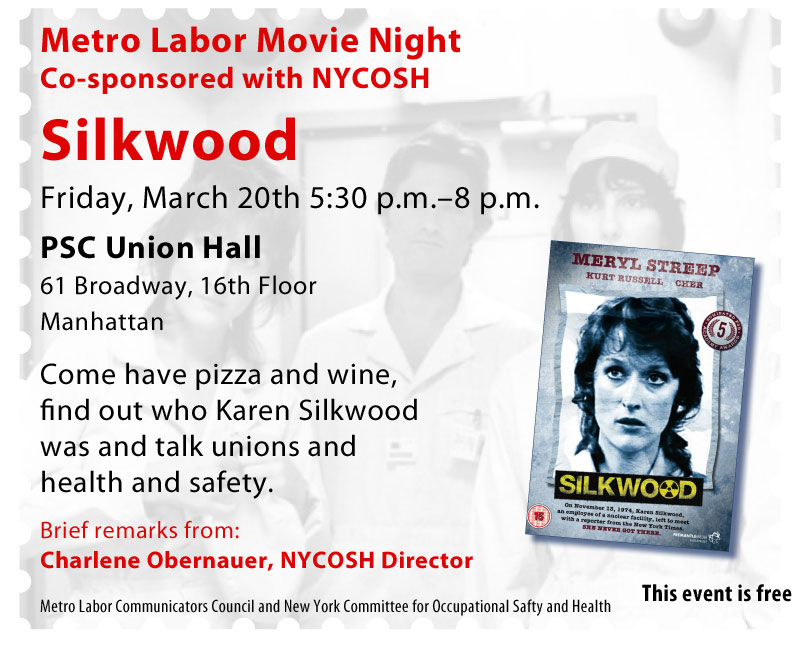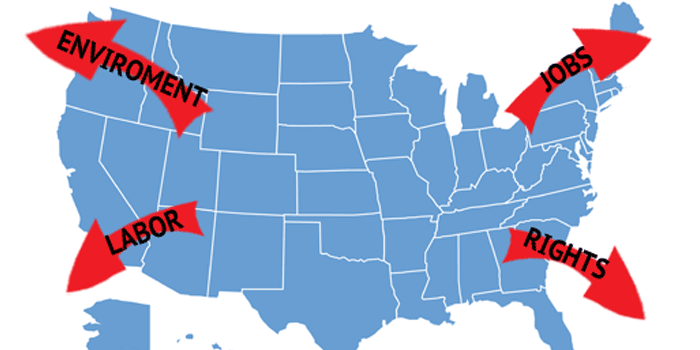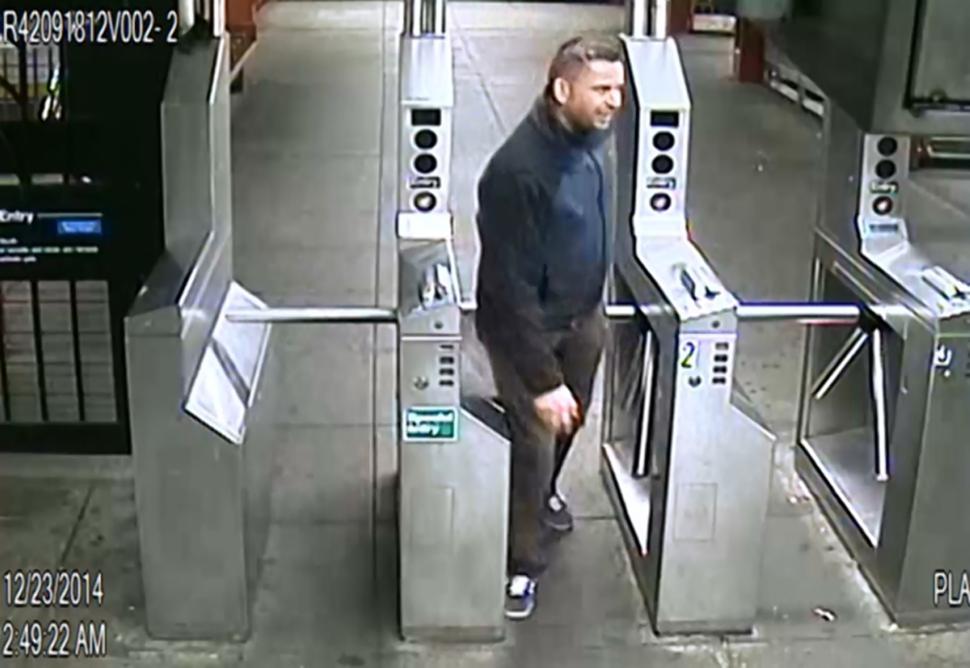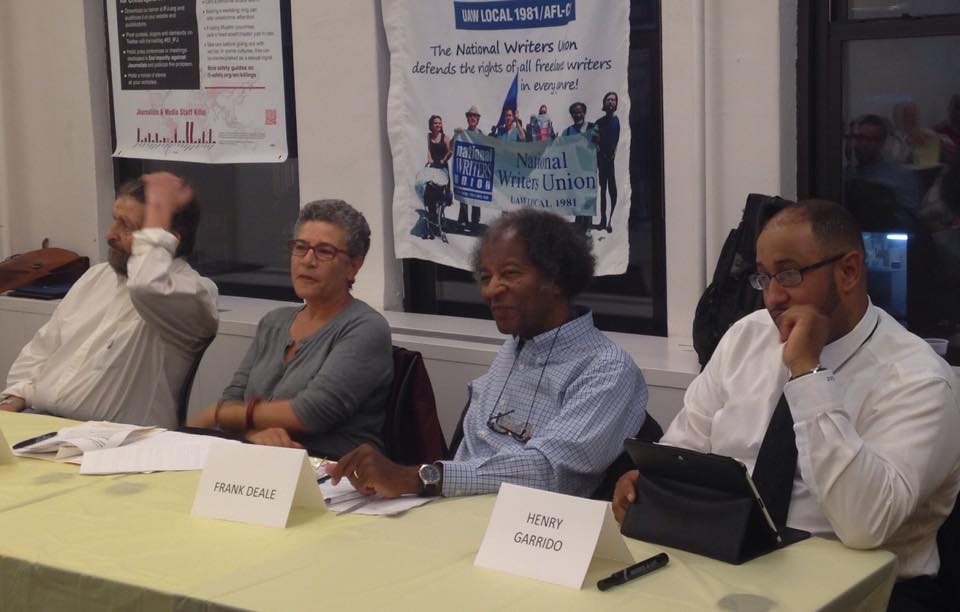You can rest, for a few minutes. Metro contest deadline has been extended to Friday, April 3rd.
The Debra E. Bernhardt Labor Journalism Prize
The New York Labor History Association is pleased to announce this Call for Entries for the First Annual Debra E. Bernhardt Labor Journalism Prize. The deadline for entries is Tuesday September 1, 2015. The Bernhardt Prize is an award of $500 given to an article or series of articles that furthers the understanding of the history of working people. The work should be published – in print or online – in a union or workers’ center publication or by an independent journalist. By sponsoring this award we hope to inspire more great writing for a general audience about the history of work, workers, and their organizations. The award is co-sponsored by LaborArts; Metro New York Labor Communications Council; the NYC Central Labor Council, AFL-CIO; and the Robert F. Wagner Labor Archives at NYU’s Tamiment Library.
For more information please use the link below.
We Need To Tell Congress To Stop TPP Fast Track And Here’s Why | NYSAFLCIO
President Samuelsen Reacts to Lenient Court Treatment of Off Duty Police Officer in Assault of Female Conductor | TWU Local 100
Andrew Cuomo is busting unions for the holidays
Daily Kos, cross-posted from The Albany Project.
What are you doing for the holidays this year? Maybe baking some cookies or trimming a tree? Maybe you’re frying up some delicious latkes and sufganiyot. What’s New York Gov. Andrew Cuomo doing for the holidays this year? He’s busting a union that endorsed his primary challenger. Merry Christmas, suckers!
In a move that has sent shock waves through the state’s unionized workforce, the Cuomo administration on Monday sent notices to about 1,000 members of the Public Employees Federation telling them the state is seeking to reclassify the recipients as non-union workers.
Head below the fold to learn more about his holiday plans.
That’s one way to lessen the influence of a union that has been less than supportive of your anti-worker ways, I guess. You just wish 1,000 or so of them away. Workers were shocked to discover that the notices they were sent from the Cuomo administration weren’t holiday cards.
Employees who were handed the notices were asked to sign them on the spot to acknowledge that they received them, although not everyone complied.”We were just handed this,” one union member said of the notices.
That’s pretty Scrooge-y, no?Cuomo and the PEF have been at odds over reclassification since last year, with the governor trying to reclassify hundreds of other workers out of the union. But this latest maneuver is unusually large and rather transparently punitive. Attempting to reclassify roughly a thousand workers all in one stroke of Cuomo’s union busting pen is pretty bold, even for Cuomo.
PEF isn’t taking this lying down, however. They plan to fight.
PEF officials later in the day emailed members saying they will resist the attempt to pull the workers out of the union.”Be assured we will be fighting this,” union President Susan Kent told members in an email.
We all know that nobody can carry a grudge like Andrew Cuomo. And it’s really hard not to see this move as straight up retaliation for PEF’s very vocal endorsement of Zephyr Teachout in the Democratic primary. PEF isn’t a fan of the governor for what should be obvious reasons. And Andrew Cuomo pretty obviously is using his office to bloody a union that he perceives as insufficiently supportive.Happy Holidays from Andrew Cuomo.
Climate Works Launch Forum | ALIGN PowerBase
 Climate Works Launch Forum | ALIGN PowerBase.
Climate Works Launch Forum | ALIGN PowerBase.
On December 16th there will be a Climate Works for All Forum called by ALIGN, NYC CLC, Blue Green Alliance amongst others. See link for more info and to sign up.
Steven Greenhouse takes N.Y. Times buyout
Steven Greenhouse, one of two national labor reporters, is leaving the Times. Greenhouse is a previous recipient of the Metro Communicator of the Year.
The Chief covers Metro panel
Urge New Role for Unions Who You Gonna Call? Not Just for Trouble
By DAN ROSENBLUM
One of the biggest problems with workers’ perspectives of unions can best
be summed up as what one labor leader calls the “Ghostbusters effect.”
“You have a problem in the workplace, who are you going to call?
Ghostbusters,” said District Council 37 Associate Director Henry Garrido,
describing how, to many members, unions enter the workplace to try to
resolve grievances and contract disputes and disappear until the next
problem arises. “So Ghostbusters comes in, takes care of the ghosts, puts
them in the canister and leaves. They come in, the employer did something
bad, you took care of the boogeyman for now and you take off. Well, we
need to change that.”
Protecting the Future
He was one of four panelists discussing how unions could move from a
defensive footing in an environment of right-to-work legislation, court
challenges and less job security. Through the more-than-two-hour
discussion, hosted Oct. 16 by the National Writers Union and the Metro NY
Labor Communications Council in a Garment District office, the panelists
worked through concerns on what could be existential threats to organized
labor.
“We have to call what’s happening to labor in this country for what it is:
it’s war,” Mr. Garrido said.
Mr. Garrido, who will become DC 37’s executive director when Lillian
Roberts retires at the end of this year, pointed to the recent U.S.
Supreme Court ruling in Harris v. Quinn, which established this summer
that home-health-care workers in Illinois could opt to withhold union dues
but retain union protections, as one of the most-ominous developments for
labor.
Though many public-sector unions say they “dodged a bullet,” Mr. Garrido
said Justice Samuel Alito wrote pages of arguments providing a basis for a
further legal challenge. There are now several cases proceeding through
courts that could further diminish the power of unions, including one
against the California Teachers Association regarding the political use of
members’ dues.
‘Biggest Threat in 30 Years’
“This is a very dangerous situation,” he said. “To me it is the biggest
threat to the labor movement in over 30 years.”
In Wisconsin, a former hotbed of the labor movement, the Wisconsin State
Employees’ Union reportedly lost 60 percent of its members in the three
years since Republican Governor Scott Walker signed a law eviscerating
collective-bargaining rights, he said.
Carol Pittman, director of political and community affairs at the New York
State Nurses Association, said with potential staff losses there were
opportunities to recruit workers to become volunteer organizers and
representatives. “I think it’s possible to build leadership from within
your members so you don’t really need as much staff,” she said.
On that “Ghostbuster effect,” Mr. Garrido said that many unions fear
empowering their rank-and-file members to deal with employers themselves.
One of the ways DC 37 approached that was to try to organize the 27,000
agency fee-payers who pay union dues but hadn’t signed up to become
members. So far, it has organized 14,000 new members, he said.
New Challenge
One of the wider challenges to union membership is the rise of at-will
workers in retail jobs and part-time labor. Frank Deale, a CUNY Law School
Professor and member of the university’s union, the Professional Staff
Congress, said that his union could show observers that many of its
workers aren’t tenured professors who teach for a couple of days per week
and spend the rest of the time engrossed in academia, but adjuncts looking
for more hours.
“The bottom line is that I think the union, PSC, kind of has to do more to
break down that perception that I think exists of us as being essentially
privileged workers, because the reality is that most of us are not,” he
said
Stanley Aronowitz, a sociology professor at the City University of New
York who recently published “The Death and Life of American Labor,” said a
major issue was organized labor being looked at as an “interest group”
rather than a “class movement.”
“And if it’s not a class movement, then it might as well go home and pack
its bags,” he said. “It’s not a movement anymore; it’s an insurance
company masquerading as a movement.”
Make Some Noise
After some audience prodding on how to spread an awareness of the labor
movement and incentives for younger workers, the panelists expressed some
optimism, tempered by a call for unions to be more vocal about their
advantages. Mr. Garrido said unions offer higher wages and better
health-insurance and pension deals than non-affiliated workers can get,
but to gain currency among new college graduates, unions needed to argue
on their own behalf and speak louder about college debt.
“We just somehow expect them to gravitate to us like we’re rock stars
coming out of a concert and somehow, because they heard our music, they’re
going to come gravitate to us,” he said.
Mr. Aronowitz said labor should not look to the major political parties or
legislation for help. “The labor movement grew and prospered when it
regarded the law at a distance,” he said, noting the National Labor
Relations Act was one of the sole exceptions. “…We began to feel, I
think mistakenly, that the law was on our side. The law has never been on
our side.”
Citing disappointments from unions failing to “break with” Governor
Cuomo-who has gotten unenthusiastic backing from those who have stumped
for him-and other national Democrats who he said haven’t supported unions’
goals, Mr. Aronowitz later blamed labor for not coalescing around
alternatives like Mr. Cuomo’s primary challenger, Zephyr Teachout.
Instead, he said local organizing and rebuilding a willingness to strike
was a good way to again galvanize labor organizations whose power is
declining.
“I’m not saying this is permanent: you know, by the year 2050, things will
turn around,” he said. “And that’s half a joke-but it’s only half a joke.”
Reprinted from The Chief (http://thechiefleader.com/) Monday, October 20, 2014 5:30 pm | Updated: 2:22 pm, Tue Oct 21,
2014.





